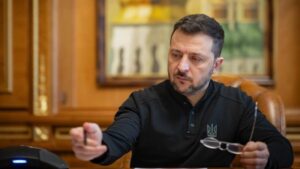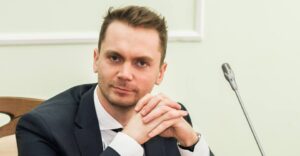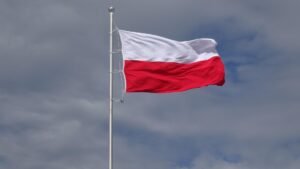
Ukrainian President Volodymyr Zelensky has formed a delegation to participate in negotiations with the United States and other international partners of Ukraine, as well as with representatives of the Russian Federation. The delegation will be headed by the head of the President’s Office, Andriy Yermak.
Decree No. 854/2025, signed on November 22, “On the Ukrainian delegation to participate in the negotiation process with the United States of America and other international partners of Ukraine, as well as with representatives of the Russian Federation, to achieve a just and sustainable peace,” is posted on the website of the Office of the President.
The delegation consists of nine high-ranking officials, including the head of the delegation, Head of the Office of the President Andriy Yermak, Secretary of the National Security and Defense Council of Ukraine Rustem Umerov, and Head of the Main Intelligence Directorate of the Ministry of Defense of Ukraine Kirill Budanov. It also includes Chief of the General Staff of the Armed Forces of Ukraine Andriy Hnatov, Chairman of the Foreign Intelligence Service of Ukraine Oleg Ivashchenko, First Deputy Minister of Foreign Affairs of Ukraine Serhiy Kyslytsya, First Deputy Secretary of the National Security and Defense Council of Ukraine Yevhen Ostryansky, Deputy Chairman of the Security Service of Ukraine Oleksandr Poklad, and Advisor to the Head of the Office of the President of Ukraine Oleksandr Bevz.
According to the decree, Yermak, as head of the delegation, is authorized to make changes to the composition of the Ukrainian delegation in agreement with the President of Ukraine; to involve, in accordance with the established procedure, employees of state bodies, enterprises, institutions, organizations (in agreement with their heads), scientific advisers, and experts (with their consent) to ensure the work of the Ukrainian delegation.

The Temporary Investigation Commission is trying to determine whether there was influence on the Public Integrity Council, but the key witness refuses to appear before the Verkhovna Rada.
An attempt was made to forcibly bring Mikhail Zhernakov, head of the DEJURE Foundation, to a meeting of the Verkhovna Rada’s Temporary Investigation Commission on the investigation of possible corruption or corruption-related offences in law enforcement agencies, courts, and judicial authorities, known in the media as the “Vlasenko-Buzhansky Commission.”
The summons was related to the fact that the TSC is trying to determine whether the DEJURE Foundation and Mikhail Zhernakov personally influenced the formation and activities of the Public Integrity Council. The latter plays a certain role in judicial reform, as it was intended to exercise public control over the integrity of candidates for judicial power.
For example, on November 4, the TSK questioned Tatyana Katrichenko, co-author of a column in Ukrainska Pravda, but did not receive any specific answers from her. Mikhail Zhernakov could not be questioned because he did not attend the TSK meeting at all.
Zhernakov himself complained that the National Police tried to break into his house and claimed that the TSK does not have the authority to summon public activists or conduct investigations against them, and allegedly “set out to attack independent institutions and public organizations that are cleaning up the system.”
In addition, he said that he had a more important reason for not attending the Verkhovna Rada, namely that he was going to a “high-level meeting.”
All events took place in the elite Elyseum residential complex, where, according to media reports, the cheapest apartment costs about $160,000 without renovation.
The next meeting of the TSK will take place on November 24, 2025, and the agenda item to be considered is the presence of signs of abuse of influence and other possible corruption offenses in the formation and activities of the third and fourth compositions of the Public Integrity Council.
What is Mikhail Zhernakov known for?
Career as a judge
In 2012, then-President Viktor Yanukovych appointed him judge of the Vinnitsa District Administrative Court. On September 30, 2013, the High Qualification Commission of Judges recommended him for permanent transfer to the position of judge of the District Administrative Court of Kiev.
According to the Judicial and Legal Newspaper, Mikhail Zhernakov was absent from work for 449 (!) days between 2012 and 2015. For example, from January to September 2015, he considered only 76 administrative cases.
In July 2015, he submitted his resignation from the position of judge at his own request.
Evasion of military service
According to media reports, on December 14, 2023, Mikhail Zhernakov was detained in Kyiv by officers of the TCC and SP and forcibly taken to the Shevchenkivskyi District TCC and SP. The reason was a violation of the rules of military registration for conscripts.
A report was drawn up against Zhernakov under Part 2 of Article 210-1 (violation of legislation on defense, mobilization preparation, and mobilization) of the Code of Administrative Offenses.
Zhernakov did not contest the actions of the TCC and on December 20, 2023, paid a fine of 5,300 hryvnia.
Later, he got a job as an expert at the Ministry of Defense’s “Office of Change.”
At the same time, back in June 2023, Zhernakov tried to get a ‘deferral’ — he got a job at the private higher education institution “Kyiv School of Economics” (KSE) at 0.75 of the standard rate.
When information about his “research and teaching activities” became public in December of the same year, a scandal erupted. The rector of KSE had to comment publicly on the situation, stating that if Zhernakov was mobilized, KSE would not object and “would wait for his return.”
– A conflict with Dmitry Krivenko, a judge of the Lipovetsky District Court of the Vinnytsia region, which arose from the story of December 15, 2021, involving judges of the Shevchenko District Court of Zaporizhia, who celebrated Court Workers’ Day in a cafe to the sound of chanson music. In January 2022, a video of the incident was posted online, after which the judges received a wave of criticism.
– Interference in the election of the head of the Supreme Court.
– Colleagues in the “civil sector” accused him of manipulating the election of members of the Public Integrity Council, promoting candidates who were personally beneficial to him to the PIC (“Zhernakov’s lists”), putting pressure on certain members of the public, intrigue, slander, “usurpation of power,” and even financial fraud involving foreign donor funds that were intended to “support judicial reform in Ukraine.”
Some critics even claimed that there may have been financial irregularities in the use of donor funds received to support judicial reform. There is no public confirmation of these allegations, and Zhernakov himself denies them.

As part of the Prioritized Ukraine Requirements List (PURL) program, Poland will allocate $100 million for the purchase of American weapons for Ukraine. The purchases will be financed from the budget of the Polish Ministry of Foreign Affairs, said the head of the ministry, Radosław Sikorski.
“Europe’s security will be enhanced or diminished as a result of how this war ends,” Sikorski stressed, according to Polsat News.
As reported, the initiative to finance the purchase of American weapons for Ukraine came after the US administration refused to continue supplying weapons to Kyiv free of charge. In August, four packages of American weapons were prepared for a total amount of about $2 billion. The funding was provided by Germany, Denmark, Canada, the Netherlands, Norway, and Sweden.
On August 15, at a meeting of NATO defense ministers in Brussels, Estonia, Latvia, Lithuania, Belgium, Luxembourg, Finland, and Iceland announced their decision to join the program to finance Ukrainian defense orders within the framework of the NATO initiative “Priority Urgent Requirements List for Ukraine” (PURL).
On October 23, Spain announced its agreement to join the PURL project in response to renewed criticism from US President Donald Trump regarding Spain’s unwillingness to increase military spending.

The Ukrainian Unity Hub in Spain will open in the city of Torrevieja in the province of Alicante, according to the Ministry of Social Policy, Family, and Unity.
“We are grateful to the Spanish side for supporting our citizens, as well as for the decision to transfer premises for the Ukrainian Unity Hub in Torrevieja,” the press service quoted Deputy Minister of Social Policy Ilona Gavronska as saying following a working visit to Spain.
It is noted that during this visit, she met with the Ukrainian community, where the concept of the Unity Network was presented and discussed with the participants of the event.
The ministry noted that almost a quarter of all Ukrainians with temporary protection status in Spain live in the province of Alicante.
As reported, on January 24, the Cabinet of Ministers approved the creation of the Agency for National Unity, a structure that will help implement initiatives for interaction with the Ukrainian community and public organizations in the countries of residence. It was noted that the Agency will open departments in key countries of residence of Ukrainians, primarily in Germany, Poland, and the Czech Republic, and Unity Hubs will be created in the capitals of these countries. The Unity Hub’s functions and capabilities include: an educational and cultural space, language courses, a return consultant, consular services (as an external service), banking services, postal services, an economic opportunities coordinator, DP “Document,” opinion leader meetings, programs for children and youth, a Ukrainian coffee shop, a business hub and coworking space, and a UA Job Center.
In February, a joint declaration of intent was signed to open the first Ukrainian Unity Hub in Berlin. There are plans to open such hubs in Munich and Düsseldorf.
In March, joint declarations of intent were signed to open Ukrainian Unity Hubs in France and Spain.
In early November, the Ministry of Social Policy announced that Ukrainian Unity Hubs would open in Spain, Germany, and the Czech Republic in 2025.

The production of bio-glue from peas, which is necessary for the manufacture of eco-friendly wood panels for the construction and furniture industries, has started in the Korosten Industrial Park (Zhytomyr region), invested in by the Korosten MDF Plant owned by businessman Leonid Yurushev and his family.
“A unique production facility has started operating in the Korosten Industrial Park in Zhytomyr region. It has launched the production of bio-glue from peas. The total investment in this project is EUR 40 million,” wrote Dmytro Kysilevsky, deputy chairman of the Verkhovna Rada Committee on Economic Development, on Facebook.
He stressed that the launch of such production is sensational news for the Ukrainian agricultural sector, since the demand for new production is 1 million tons of peas per year, which is more than twice the gross harvest of this crop in 2024. Therefore, until Ukrainian farmers increase the area under this crop, part of the production needs will be covered by imports from Hungary and Poland.
According to him, the investor of the Korosten MDF Plant project is currently consulting with farmers in the Zhytomyr, Kyiv, Cherkasy, Kirovohrad, and Dnipropetrovsk regions on expanding the acreage and long-term contracts for the supply of peas.
“The climate in these regions allows for two pea harvests per year,” Kysilevsky added.
The new plant’s design capacity is 3,000 tons of bio-glue per month, with planned production volumes of eco-boards at 20,000 cubic meters per month.
To implement the project, the investor took advantage of the opportunity to import equipment without paying VAT, which is provided for by law for participants in industrial parks.
The MP recalled that last fall, IP Korosten, as part of a state project to develop the infrastructure of industrial parks on a 50/50 co-financing basis, attracted UAH 83.5 million from the state for the construction of an access road.
“At the same time, a similar enterprise, Korosten MDF Plant, is building in the BF Terminal industrial park (Zakarpattia region). 90% of eco-boards are planned to be exported. These products comply with EU regulations, which, from August 6, 2026, will tighten the requirements for formaldehyde content in adhesive mixtures for MDF and HDF board manufacturers,” Kysilevsky said.
He recalled that IP Korosten covers an area of 42.2 hectares and brings together a cluster of woodworking companies, including Ukrainian Holding Sawmill Company, Rezalt Eco, Korosten MDF Plant, BF Engineering, and BF Project.
According to YouControl, Korosten MDF Plant ended 2024 with a loss of UAH 9.8 million, while in 2023 it received a net profit of UAH 237 million, and its net income decreased by a quarter to UAH 1.89 billion. In January-September this year, its loss amounted to UAH 18.4 million, and its revenue was UAH 1.46 billion.

On Saturday, November 22, in Zakarpattya, Lviv and Ivano-Frankivsk regions heavy rain and wet snow, in the western regions of sticking wet snow, ice, on the roads icy; in the Carpathians heavy wet snow, warns Ukrhydrometcenter.
“November 22 in Zakarpattya, Lviv and Ivano-Frankivsk regions significant precipitation (rain and wet snow), in the western regions of the sticking of wet snow, ice, on the roads icy (I level of danger, yellow); in the Carpathians heavy wet snow (II level of danger, orange)”, – stated in the message of the Ukrainian hydrometeorological center.
It is noted that weather conditions may lead to complications in the work of energy, construction, utility companies and disruption of traffic on roads and streets (I level of threat, yellow), on the passes of the Carpathians (II level of threat, orange).